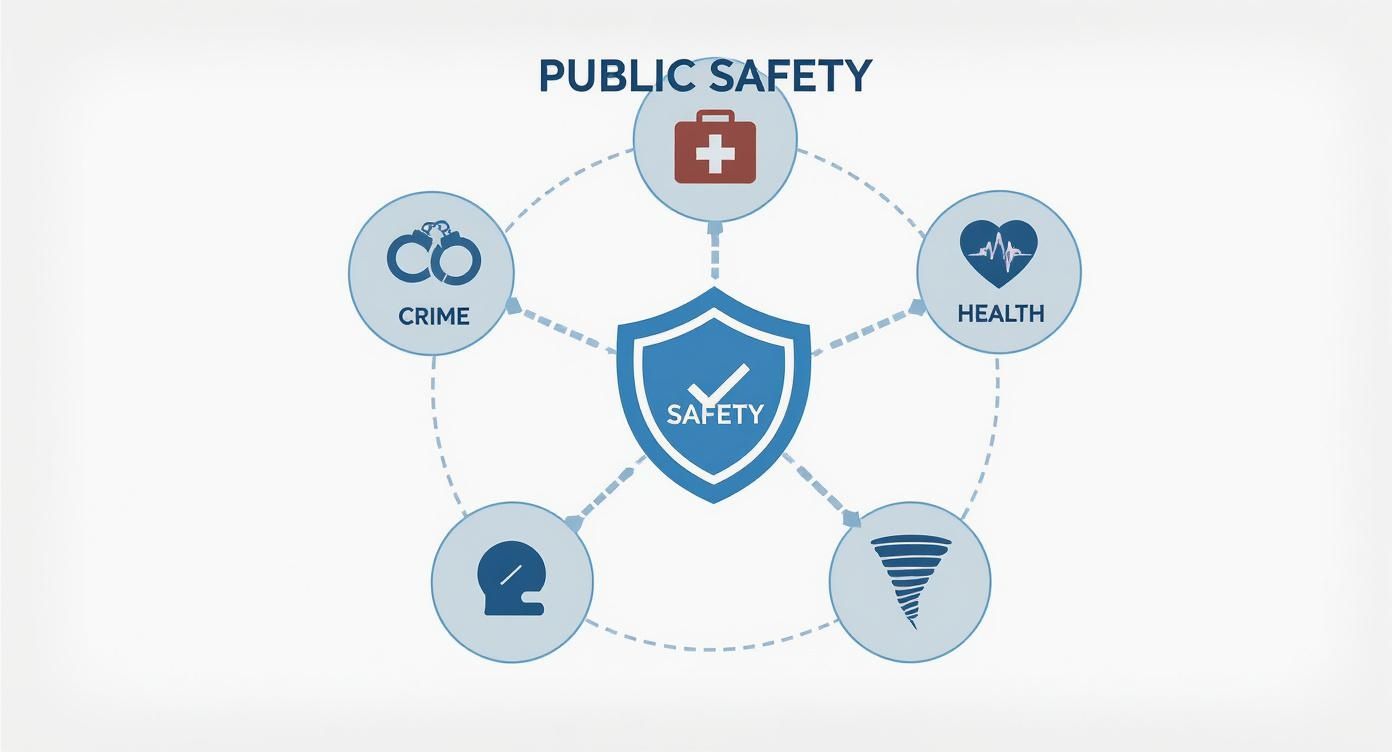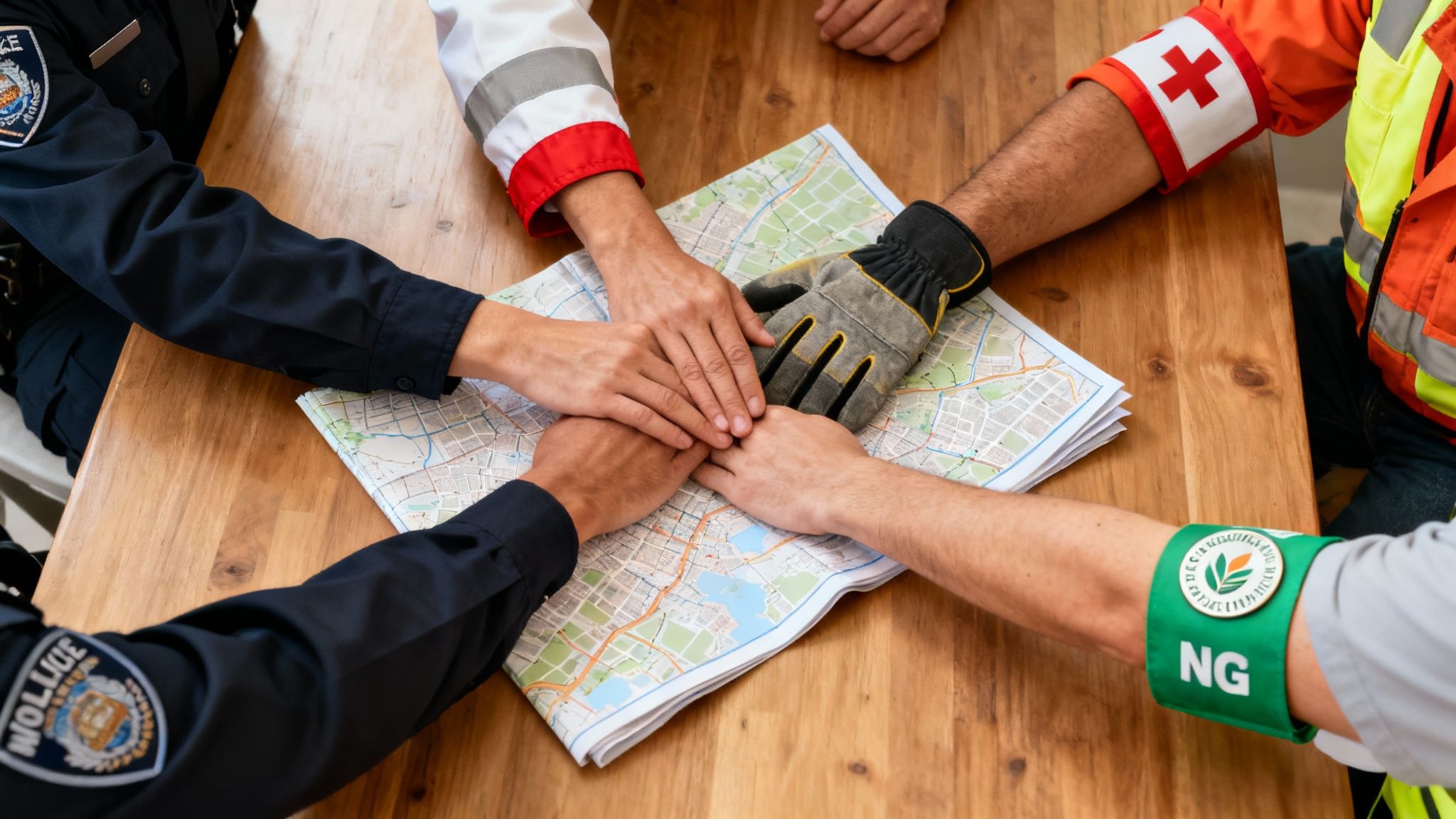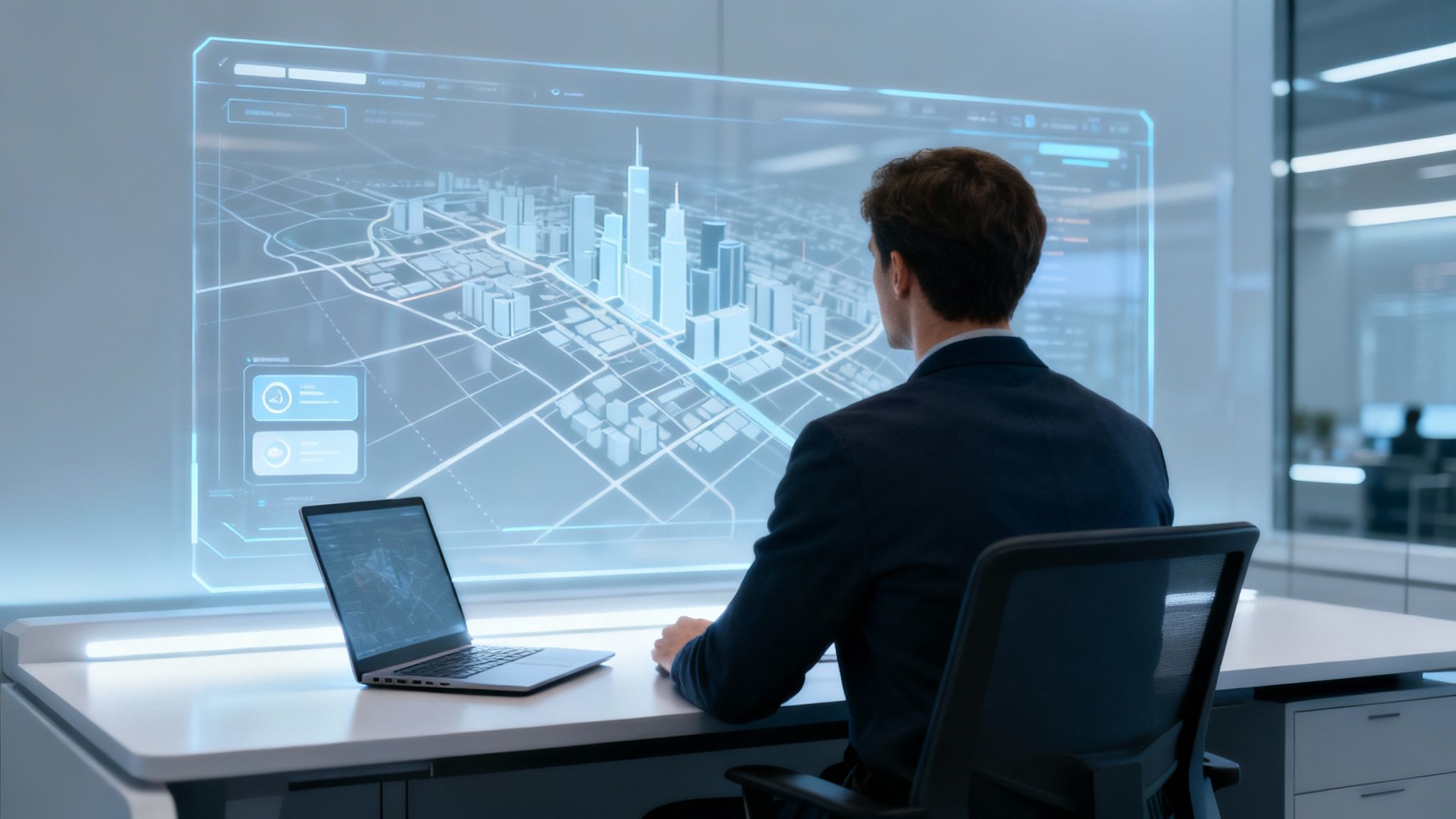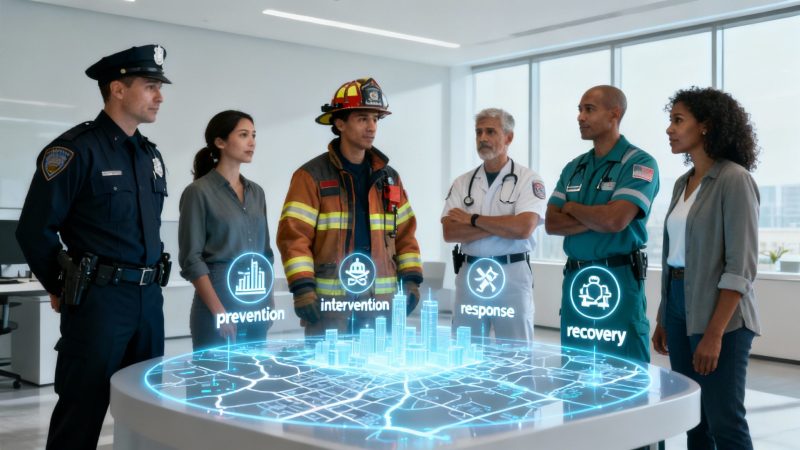define public safety: A Modern Agency Guide
When you hear "public safety," your mind probably jumps straight to police cars and fire trucks. And you're not wrong—that's definitely a big piece of the puzzle. But the real meaning of public safety today is much broader and more complex.
It’s less about a single response and more about a continuous, proactive system designed to keep a community and its people secure. I like to think of it as a city's immune system. It’s always working in the background to spot and stop threats before they happen, react quickly when they do, and help everyone get back on their feet afterward.
This system has to be ready for anything, from violent crime and traffic accidents to failing infrastructure and public health crises. A truly safe community isn't just one with a low crime rate; it's also one that can bounce back from a hurricane or handle an unexpected emergency without falling apart.
A Global Perspective on Safety
Looking around the world, it’s clear that building strong public safety frameworks has never been more important. Things are tense out there. According to the Global Peace Index (GPI), global peace is at its lowest point since the index was created.
The conditions that lead to conflict are worse than they've been at any time since World War II. A recent year saw 59 active state-based conflicts and a staggering 152,000 conflict-related deaths. This global context really drives home why our local public safety efforts are so vital for keeping our own communities stable and resilient.
The Four Pillars of Public Safety
To really get our arms around what "public safety" means, it helps to break it down into its core components. Think of them as the four pillars holding everything up. Each one has a critical job, but they all have to work together to create a genuinely secure environment.
Here’s a quick look at these essential components and how they fit together.
The Four Pillars of Public Safety
| Pillar | Primary Focus | Key Stakeholders |
|---|---|---|
| Law Enforcement | Crime prevention, investigation, and maintaining order. | Police departments, sheriff's offices, federal agencies. |
| Fire and Rescue | Fire suppression, emergency medical response, and hazardous material incidents. | Municipal fire departments, volunteer fire companies. |
| Emergency Medical Services | Pre-hospital medical care, patient transport, and emergency response. | Paramedics, EMTs, ambulance services. |
| Emergency Management | Planning for and responding to large-scale disasters and emergencies. | FEMA, state and local emergency management agencies. |
Each pillar is a specialty in its own right, but no single one can protect a community alone. True public safety is achieved when law enforcement, fire, EMS, and emergency management are all in sync, sharing information and coordinating their efforts seamlessly.
Building a Modern Public Safety Framework
If you want to get to the heart of what modern public safety really is, you have to stop thinking about it as a single action. It’s not just about what happens after a 911 call. Instead, think of it as a complete cycle—a robust system built on four interconnected pillars: prevention, intervention, response, and recovery.
Each stage is absolutely critical for building a community that isn't just secure, but resilient. This mindset is what moves an agency from a purely reactive stance to a proactive one. It’s a shift that’s not only more effective at protecting people but is also way more cost-efficient. An investment in heading off a problem is almost always cheaper than cleaning up the mess afterward.
The Four Pillars Explained
Let's break down what these pillars actually look like on the ground.
- Prevention: This is all about stopping bad things from happening in the first place. We're talking about community policing initiatives that build genuine trust or public health campaigns that hammer home fire safety tips. For example, a fire department spending $5,000 on smoke detectors for low-income housing can prevent a single structure fire that would cost over $200,000 in emergency response and damages. These actions are designed to stop that 911 call from ever being made.
- Intervention: This is for situations that are getting hot but haven't boiled over into a full-blown crisis. A great example is dispatching a specialized mental health team to de-escalate a behavioral health emergency. You avoid a volatile encounter, prevent an unnecessary ER visit (which can cost thousands per incident), and get the person the right kind of help.
- Response: This is the pillar everyone knows—the classic emergency response. It's the lights and sirens. Police, fire, and EMS rolling up to the scene of an accident, crime, or medical event to provide immediate, life-saving aid.
- Recovery: The job isn't over when the sirens fade. This final stage is all about putting things back together. It can be as massive as disaster relief after a hurricane or as focused as repairing critical infrastructure and offering long-term community support.
The infographic below really drives home how different threats—from crime to public health crises to natural disasters—all fall under the same public safety umbrella.

This shows you that a truly comprehensive strategy has to tackle a whole range of risks, not just one or two. Think about it: a proactive investment in preventative mental health services (Pillar 1) can directly reduce the number of costly emergency calls and hospitalizations (Pillar 3). That saves public money and, just as importantly, frees up first responders for other critical incidents.
Part of this modern approach also means protecting your own operational data. You can learn more about securing your systems by reading about Resgrid's commitment to security.
Mapping Your Key Stakeholders and Their Roles
When you're trying to nail down what public safety really is, you have to think of it as a team sport. It's not a solo mission for uniformed officers. Trying to manage a large-scale emergency with just one agency is like trying to put on a symphony with only a violin—it just doesn't work.

Picture your public safety ecosystem as an orchestra. Law enforcement might be the powerful brass section, setting the tone. EMS is the responsive string section, providing immediate care. Each group is essential, but they have to play in harmony for the performance to be a success.
The Core Players on the Field
The very first step toward solid collaboration is simply identifying everyone who needs a seat at the table. While the specific players will change from one community to the next, they usually fall into three main buckets:
-
Governmental Agencies: These are the folks you see most often—police departments, fire and rescue services, and emergency management offices. They're the frontline responders and the command structure when a crisis hits.
-
Non-Governmental Organizations (NGOs): Think groups like the American Red Cross or local community watch programs. They're vital support players, bringing critical resources like temporary shelter, food, and organized volunteers to fill the gaps that government agencies can't always cover.
-
Private Sector Partners: These partners are absolutely indispensable, even if they're often overlooked. Utility companies work to get the power back on, private security firms protect assets, and telecom companies keep the lines of communication open.
Actionable Insight: Building strong public-private partnerships before a disaster is one of the smartest ways to save money down the road. Pre-negotiated contracts with private debris-removal companies or fuel suppliers can slash operational costs and response times compared to scrambling for resources in the middle of a crisis. For instance, a pre-storm contract can lock in fuel prices, saving tens of thousands of dollars when demand (and price) skyrockets.
Think about what happens when a hurricane is bearing down. The police are managing evacuations while utility companies are working to protect the power grid. At the same time, the Red Cross is setting up shelters. When these groups coordinate their plans ahead of time, resources get where they need to go, efficiently.
This kind of teamwork prevents costly duplication of effort and ensures that help reaches the people who need it most, faster and cheaper. A well-rehearsed orchestra always delivers a better performance.
It's one thing to talk about public safety in theory, but seeing it work in the real world is where it all really starts to make sense. These are the moments you see how all the pieces—proactive planning, stakeholder teamwork, and modern tech—fit together to keep people safe and manage critical resources.
When you get down to it, public safety isn't just about crime. It's about protecting people from all kinds of harm, including accidents and infrastructure failures. Take the Safety Index from the Global Residence Index. Their data shows that in a lot of countries, you're far more likely to die in a traffic accident or a natural disaster than from a homicide.
This just drives home the point that keeping citizens safe is a much bigger job than just policing. It means building resilient infrastructure and strong social systems. You can really see this broader scope in action during a major event, where success or failure often comes down to seamless coordination.
A Natural Disaster: The Hurricane Response
Picture this: a Category 4 hurricane is barreling toward the coast, expected to make landfall in 72 hours. A solid public safety response doesn't start when the warning is issued; it starts years earlier with good, solid emergency preparedness plans.
-
Pre-Positioning Resources: Instead of a last-minute scramble for supplies, agencies use predictive analytics to get assets in place ahead of time. Water, medical kits, and generators get moved to safe zones just outside the storm’s projected path. This simple step saves an incredible amount of time and money on logistics when the roads eventually become impassable. This proactive move can cut fuel and overtime costs by 20-30% compared to a reactive deployment.
-
Coordinated Evacuations: This is where the teamwork really shows. Law enforcement works with transportation departments to manage contraflow traffic, getting more people out faster. At the same time, emergency management is blasting out clear evacuation orders through mass notification systems. It’s a multi-agency effort designed to prevent gridlock and get as many people as possible to safety.
Of course, none of this works without reliable communication. In the heat of the moment, tools like the various public safety apps from Resgrid are invaluable for streamlining messages and keeping track of personnel when every second is critical.
A Public Health Crisis: The Pandemic
A global pandemic puts a different kind of strain on the public safety ecosystem. In this scenario, public health agencies are in the driver's seat. They're working hand-in-glove with EMS for patient transport and with law enforcement to secure testing sites or enforce public health orders.
When you're in a pandemic, the single most effective way to save resources is through clear, rapid communication. Getting accurate information out about prevention and available help eases the burden on emergency services and keeps the healthcare system from getting completely swamped. A simple, well-timed public service announcement about testing locations can prevent hundreds of non-emergency 911 calls, freeing up dispatchers for true emergencies.
By looking back at how these real-world events played out, agencies can build practical, adaptable blueprints for their own plans. It’s about learning from experience so you're ready to face whatever challenge comes next.
Leveraging Technology for Smarter Operations
In today's world, technology is the ultimate force multiplier for any agency serious about proactive, intelligent public safety. These aren't just gadgets for faster response times; they're tools for making smarter, data-driven decisions that can stop incidents before they happen, keep our first responders safer, and ultimately save money.

This isn't just a trend—it's a massive shift. The global public safety and security market is on track to explode, growing from $616.61 billion to over $1.13 trillion by 2029. This growth is fueled by real-world advancements in AI, smarter surveillance, and the Internet of Things (IoT). You can read more about these public safety market trends to get the full picture.
Integrated Systems and Situational Awareness
The real magic happens when you bring all this tech together. An integrated command center platform can pull real-time information from a dozen different places—traffic cams, building plans, social media chatter, and GPS locations of officers—and put it all on one screen. For dispatchers and commanders in the field, this creates an incredible level of situational awareness.
Think about it. A fire crew responding to a blaze could have the building's floor plans and know exactly where hazardous materials are stored before they even pull up to the scene. Or imagine a search and rescue mission where drones with thermal cameras can sweep over miles of rough country in the time it would take a ground team to cover a few hundred yards.
Actionable Insight: An investment in automated systems yields a significant return. For example, adopting automated reporting software can free up thousands of officer-hours previously spent on paperwork, translating directly into long-term savings and more time for community engagement. If an officer saves just 30 minutes per shift on paperwork, a 100-officer department reclaims over 9,000 hours per year—the equivalent of four full-time positions.
Of course, it's not all about big municipal systems. Individual actions and specific tools, like implementing effective car security systems, also play a crucial role in the broader public safety ecosystem.
Making Smart Investments
The trick is to invest in technology that actually solves your agency's specific problems. For instance, some departments are using AI-powered predictive analytics to identify crime hotspots, which lets them deploy patrols where they're needed most, instead of just guessing.
Using technology this way doesn't just improve outcomes—it makes your budget go further. By automating the routine stuff and giving you better data to allocate resources, technology helps you do more with less. This is where platforms that bundle a wide range of dispatching and management features become so critical, allowing teams to run complex operations from a single, unified system.
Your Questions Answered
Even with a solid grasp of the big picture, a lot of agency leaders and first responders I talk to have practical questions. They want to know how all this theory applies to their day-to-day grind. So, let's get right into some of the most common questions I hear.
These aren't academic debates—they're about the real-world distinctions, budget fights, and strategic headaches that agencies of all sizes are dealing with right now.
How Is Public Safety Different From Law Enforcement?
It's a great question, and the easiest way to think about it is like this: Law enforcement is a key instrument in the much larger public safety orchestra. A police department's main job is crime prevention, investigation, and enforcing laws. That’s a critical piece of the puzzle, but it’s not the whole picture.
Public safety is the entire orchestra. It's the broad umbrella that protects the community from all hazards, not just crime. It’s law enforcement, fire services, EMS, emergency management, and public health all playing their parts in harmony. Think about a major car crash. While police are securing the scene, EMS is triaging patients, and the fire department is dealing with a fuel leak. That coordinated, multi-disciplinary effort is public safety in action.
What Is the Most Cost-Effective Way to Improve Public Safety?
Hands down, investing in prevention will give you the most bang for your buck. New engines and patrol cars are shiny and necessary, but they're reactive tools with hefty price tags. Proactive measures, on the other hand, offer a much higher return by stopping incidents before they ever start.
Actionable Insight: A simple example: A fire department sinks a small part of its budget into a smoke detector giveaway and a fire safety program for local schools. That small spend directly cuts down on residential fire calls, saving hundreds of thousands of dollars in response costs and, more importantly, preventing the tragic loss of life and property. That's a massive ROI.
For every dollar you put into prevention, you can save many more dollars down the line on emergency response, medical bills, and recovery. That's cash you can then free up for other critical needs.
How Can Small Agencies Implement Modern Public Safety Strategies?
This is a big one. Smaller agencies can get a ton done by zeroing in on two things: smart partnerships and scalable tech. You don't need a mega-budget to be effective; you just need to be smart and willing to collaborate.
-
Forge Strategic Partnerships: Why go it alone? Team up with neighboring jurisdictions to share expensive resources. Things like a regional dispatch center or a joint special response team let multiple agencies tap into advanced capabilities without each one footing the entire bill. For example, three small towns sharing the cost of a single $1 million ladder truck is far more sustainable than each trying to buy their own.
-
Adopt Scalable Technology: Go after federal and state grants to fund key tech upgrades. Affordable, cloud-based software for records management or dispatch can be a game-changer, giving you huge efficiency gains without the high cost of buying and maintaining your own servers. This is how smaller departments get access to powerful tools on a budget. Platforms like Resgrid often offer subscription models that are far cheaper than purchasing and maintaining on-premise hardware and software.
By focusing on teamwork and smart tech buys, even the smallest departments can build a modern, effective public safety framework that keeps their community safe without breaking the bank.
Effective communication and coordination are the backbone of any public safety strategy. Resgrid provides a unified, open-source platform that brings your dispatching, messaging, and personnel tracking into one seamless system. See how Resgrid can save your agency time and money at https://resgrid.com.

